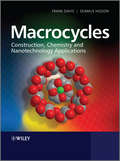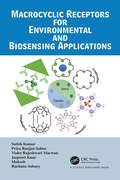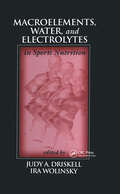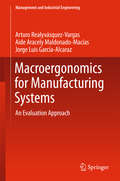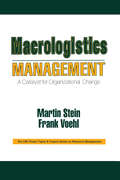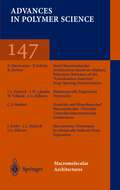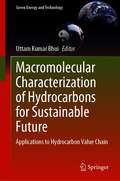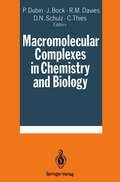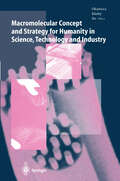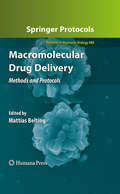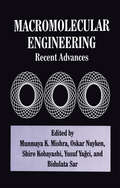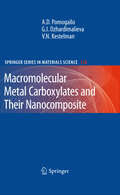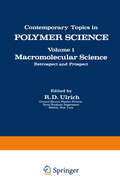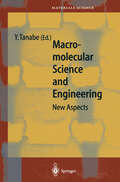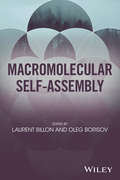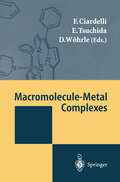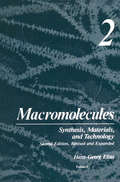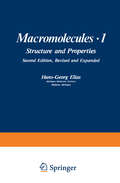- Table View
- List View
Macrocycle-Functionalised Nanosensors
by Weng-I Katherine Chio Tung-Chun LeeThe growing demand for the detection of trace analytes, such as drugs, biomarkers, environmental pollutants, and explosives, in different fields including on-site healthcare monitoring, disease diagnostics, environmental monitoring, and homeland security has driven the development of high-performance sensors to tackle real-world problems. Self-assembly of nanoparticles mediated by macrocyclic molecules provides a facile method to fabricate nanosubstrates with precise interparticle spacings, leading to very strong and reproducible signals. This introductory book is designed to offer fundamental insights into the nanosensing platforms based on macrocycle-functionalised nanoparticles, including their synthesis and functionalisation, host–guest chemistry, and optical spectroscopies. It also explores potential applications of these nanosensing platforms in biological and chemical sensing.
Macrocycles: Construction, Chemistry and Nanotechnology Applications
by Frank Davis Séamus HigsonMacrocyclic molecules contain rings made up of seven or more atoms. They are interesting because they provide building blocks for synthesizing precise two or three dimensional structures – an important goal in nanotechnology. For example, they can be used to develop nanosized reaction vessels, cages, switches and shuttles, and have potential as components in molecular computers. They also have applications as catalysts and sensors. Macrocycles: Construction, Chemistry and Nanotechnology Applications is an essential introduction this important class of molecules and describes how to synthesise them, their chemistry, how they can be used as nanotechnology building blocks, and their applications. A wide range of structures synthesised over the past few decades are covered, from the simpler cyclophanes and multi-ring aromatic structures to vases, bowls, cages and more complex multi-ring systems and 3D architectures such as “pumpkins”, interlocking chains and knots. Topics covered include: principles of macrocycle synthesis simple ring compounds multi-ring aromatic structures porphyrins and phthalocanines cyclophanes crown ethers, cryptands and spherands calixarenes, resorcinarenes, cavitands, carcerands, and heterocalixarenes cyclodextrins cucurbiturils cyclotriveratylenes rotaxanes catenanes complex 3D architectures, including trefoils and knots Macrocycles: Construction, Chemistry and Nanotechnology Applications distills the essence of this important topic for undergraduate and postgraduate students, and for researchers in other fields interested in getting a general insight into this increasingly important class of molecules.
Macrocycles: Construction, Chemistry and Nanotechnology Applications
by Frank Davis Séamus HigsonMacrocyclic molecules contain rings made up of seven or more atoms. They are interesting because they provide building blocks for synthesizing precise two or three dimensional structures – an important goal in nanotechnology. For example, they can be used to develop nanosized reaction vessels, cages, switches and shuttles, and have potential as components in molecular computers. They also have applications as catalysts and sensors. Macrocycles: Construction, Chemistry and Nanotechnology Applications is an essential introduction this important class of molecules and describes how to synthesise them, their chemistry, how they can be used as nanotechnology building blocks, and their applications. A wide range of structures synthesised over the past few decades are covered, from the simpler cyclophanes and multi-ring aromatic structures to vases, bowls, cages and more complex multi-ring systems and 3D architectures such as “pumpkins”, interlocking chains and knots. Topics covered include: principles of macrocycle synthesis simple ring compounds multi-ring aromatic structures porphyrins and phthalocanines cyclophanes crown ethers, cryptands and spherands calixarenes, resorcinarenes, cavitands, carcerands, and heterocalixarenes cyclodextrins cucurbiturils cyclotriveratylenes rotaxanes catenanes complex 3D architectures, including trefoils and knots Macrocycles: Construction, Chemistry and Nanotechnology Applications distills the essence of this important topic for undergraduate and postgraduate students, and for researchers in other fields interested in getting a general insight into this increasingly important class of molecules.
Macrocyclic Receptors for Environmental and Biosensing Applications
by Satish Kumar Jaspreet Kaur Priya Ranjan Sahoo Violet Rajeshwari Macwan Mukesh Rachana SahneyThe book is designed to highlight the utility of supramolecular systems in diverse areas such as sensing of ionic and molecular analytes, aggregation, artificial molecular machines, biology, and medicine. The synthetic chemistry of a diverse set of supramolecules encompassing various supramolecular interactions involved in driving macrocyclic architectures is discussed. Attempts have been made to cover unique features of macrocycles viz. control over shape, size, and valency along with supramolecular interactions, which direct complex supramolecular systems. The book also provides a discussion on the similarity between macrocyclic host-guest systems and biomolecules, which lay the foundation of building modern artificial molecular motors and switches like protein machines for application in diverse areas. The authors hope that the book will appeal to a wider audience of students and researchers in academics and/or industries.
Macrocyclic Receptors for Environmental and Biosensing Applications
by Satish Kumar Jaspreet Kaur Priya Ranjan Sahoo Violet Rajeshwari Macwan Mukesh Rachana SahneyThe book is designed to highlight the utility of supramolecular systems in diverse areas such as sensing of ionic and molecular analytes, aggregation, artificial molecular machines, biology, and medicine. The synthetic chemistry of a diverse set of supramolecules encompassing various supramolecular interactions involved in driving macrocyclic architectures is discussed. Attempts have been made to cover unique features of macrocycles viz. control over shape, size, and valency along with supramolecular interactions, which direct complex supramolecular systems. The book also provides a discussion on the similarity between macrocyclic host-guest systems and biomolecules, which lay the foundation of building modern artificial molecular motors and switches like protein machines for application in diverse areas. The authors hope that the book will appeal to a wider audience of students and researchers in academics and/or industries.
Macroelements, Water, and Electrolytes in Sports Nutrition
by Judy A. Driskell Ira WolinskyThe media extols the health benefits of good nutrition and physical activity. Since exercise and sport is becoming a bigger concern to the general public and not just elite athletes, the interest in research in this field is growing. Macroelements, Water and Electrolytes in Sport Nutrition addresses the relationship of macroelement needs and interactions to sports and exercise. Research indicates that work capacity and other measures of physical performance are influenced by the intake of water as well as several of the macroelements, including electrolytes. This book examines the convincing, and the not so convincing, evidence about the connection between exercise and sports activities and the nutrient status of individuals.Written by individuals from various academic disciplines, the book is a comprehensive, indispensable resource for scientists and practitioners with an interest in sports nutrition. It provides a review of topics related to water, macroelements, and exercise as well as identifies gaps in our knowledge, encouraging researchers to build upon the existing knowledge and advance our understanding of sport nutrition.
Macroelements, Water, and Electrolytes in Sports Nutrition
The media extols the health benefits of good nutrition and physical activity. Since exercise and sport is becoming a bigger concern to the general public and not just elite athletes, the interest in research in this field is growing. Macroelements, Water and Electrolytes in Sport Nutrition addresses the relationship of macroelement needs and interactions to sports and exercise. Research indicates that work capacity and other measures of physical performance are influenced by the intake of water as well as several of the macroelements, including electrolytes. This book examines the convincing, and the not so convincing, evidence about the connection between exercise and sports activities and the nutrient status of individuals.Written by individuals from various academic disciplines, the book is a comprehensive, indispensable resource for scientists and practitioners with an interest in sports nutrition. It provides a review of topics related to water, macroelements, and exercise as well as identifies gaps in our knowledge, encouraging researchers to build upon the existing knowledge and advance our understanding of sport nutrition.
Macroergonomics for Manufacturing Systems: An Evaluation Approach (Management and Industrial Engineering)
by Arturo Realyvásquez Vargas Aide Aracely Maldonado-Macias Jorge Luis García-AlcarazThis book introduces the main concepts of manufacturing systems and presents several evaluation approaches for these systems' evaluation. The relevant macroergonomics methods are summarized and the theoretical framework for Macroergonomic Compatibility construct is explained. This book presents a Macroergonomic Compatibility Model which proposes an instrument in the form of a Macroergonomic. The authors introduce a methodology to obtain a novel Macroergonomic Compatibility Index that enables manufacturing companies to assess and follow their progress on the implementation of macroergonomics practices.
Macrologistics Management: A Catalyst for Organizational Change (Resource Management Ser.)
by Frank Voehl Martin SteinMacrologistics Management defines the term "Macrologistics" as a means for designing a catalyst for change in any organization. The "macro" approach means seeing the big picture-to use time and place strategies for competitive advantage. It is a "breakthrough" strategy because it prioritizes "logistics" selection as a key factor in developing customer satisfaction and market penetration. Traditional management approaches the product and cost savings as key factors in their strategy. This book demonstrates how new approaches can be even more effective and more profitable-it will help you achieve complete transformation in your organization through a systematic process for managing change and by using carefully prioritized change management strategies. The framework for change, as explained in this book, is one where continuous monitoring is facilitated by a relevant and responsive information system, workers and managers are empowered and rewarded for innovation, and leaders encourage a passion for change. With Macrologistics Management you will learn how to unleash new sources of synergy-ways for various groups involved with the organization to work together-that help promote creativity and motivate an effective and rapid revolution in your workplace!
Macrologistics Management: A Catalyst for Organizational Change (Resource Management Ser.)
by Frank Voehl Martin SteinMacrologistics Management defines the term "Macrologistics" as a means for designing a catalyst for change in any organization. The "macro" approach means seeing the big picture-to use time and place strategies for competitive advantage. It is a "breakthrough" strategy because it prioritizes "logistics" selection as a key factor in developing customer satisfaction and market penetration. Traditional management approaches the product and cost savings as key factors in their strategy. This book demonstrates how new approaches can be even more effective and more profitable-it will help you achieve complete transformation in your organization through a systematic process for managing change and by using carefully prioritized change management strategies. The framework for change, as explained in this book, is one where continuous monitoring is facilitated by a relevant and responsive information system, workers and managers are empowered and rewarded for innovation, and leaders encourage a passion for change. With Macrologistics Management you will learn how to unleash new sources of synergy-ways for various groups involved with the organization to work together-that help promote creativity and motivate an effective and rapid revolution in your workplace!
Macromolecular Architectures (Advances in Polymer Science #147)
by P. Dubois C. J. Hawker J. L. Hedrick J. G. Hilborn R. Jerome J. Kiefer J. W. Labadie D. Mecerreyes W. VolksenMacromolecular Characterization of Hydrocarbons for Sustainable Future: Applications to Hydrocarbon Value Chain (Green Energy and Technology)
by Uttam Kumar BhuiThis book discusses the macromolecular characterization of hydrocarbon components and their industrial applications for sustainable future development. It provides efficient integrated solutions and feasible industrial applications for sustainable cleaner and greener future. The book covers recent trends in the use of hydrocarbons such as crude oil, coal and shale, biomass and other carbon materials. Various topics covered in this book include challenges in mature field redevelopment, enhanced oil recovery, optical characteristics of petroleum crudes-surfactants-brine solutions, challenges and issues in processing hydrocarbons, 'coal for future cleaner fuel and chemicals' and 'biomass for fuels and chemicals'. The book is useful for the researchers and professionals working in the area of petroleum engineering.
Macromolecular Complexes in Chemistry and Biology
by Paul Dubin J. Bock Richie Davis Donald N. Schulz Curt ThiesMacromolecular Concept and Strategy for Humanity in Science, Technology and Industry
by Y. Ito S. Kawabata M. Niwa S. Okamura B. Ranby Y. Sakurada K. Takakura N. YodaNew macromolecular concepts and strategies are demonstrated in this unique book. It deals with the harmonization of humanity in science, technology and industry. Particular attention is given to the relationship between the sensitivity of the human mind and the functionality of polymers such as "Shingosen". Moreover, biocompatibility of functional polymers for medical applications and fabrics is discussed as one of the prime examples of human creativity. Lessons of conventional wisdom of traditional Japanese shrine carpenters, which originated 1300 years ago in Horyuji Temple in Nara Japan, can be applied to modern business management by entrepreneurs and in high-tech industries.
Macromolecular Drug Delivery: Methods and Protocols (Methods in Molecular Biology #480)
by Mattias BeltingMacromolecular drugs hold the promise of becoming new therapeutics for several major disorders, including cancer and cardiovascular disease. This incredible potential is explored in Macromolecular Drug Delivery, a volume which gives a wide-ranging overview of contemporary methods used in the field, and which addresses the limitations presented by a lack of safe and efficient drug delivery strategies. Chapters offer information on both in vitro and in vivo methods of macromolecular delivery, thus appealing to a broad scientific audience. Composed in the highly successful Methods in Molecular Biology™ series format, each chapter contains a brief introduction, step-by-step methods, a list of necessary materials, and a Notes section which shares tips on troubleshooting and avoiding known pitfalls. Comprehensive and cutting-edge, Macromolecular Drug Delivery offers a platform for interdisciplinary collaboration, which should provide opportunities for new discoveries at the interface between disciplines. Ultimately, this cooperation will lead to the use of macromolecular drugs as novel diagnostic tools and, even more importantly, as a means to revolutionize the way we view and treat diseases.
Macromolecular Engineering: Recent Advances
by S. Kobayashi M. K. Mishra O. Nuyken B. Sar Y. YagciThis volume Macromolecular Engineering: Recent Advances has been developed based on the 1 st International Conference on "Advanced Polymers Via Macromolecular Engineering" (APME '95), June 24-29, 1995 at the Vassar College campus, Poughkeepsie, New York. In APME '95, 100 oral and over 50 poster presentations are to be delivered from scientists around the globe. The scientific program covers recent advances in macromolecu lar engineering. It is our vision that the knowledge of the past and the promise of the future are blended together in APME '95 to enrich and stimulate the scientists, which will bring about the progress of macromolecular engineering. Scientists from over 30 countries will be joining together to share this vision. Although over 150 papers are to be presented in APME '95 conference, we could not include all the papers in this book for a variety of reasons, most importantly the authors willingness to contribute to this volume in time to meet the deadline. However, the 24 comprehensive chapters included in this volume are a true reflection of some of the important themes of macromolecular engineering that are part of the APME '95 conference. We believe macromolecular engineering is the key to developing new polymeric materials and, to this end, it is hoped this volume will aid in this introspection.
Macromolecular Metal Carboxylates and Their Nanocomposites (Springer Series in Materials Science #138)
by Anatolii D. Pomogailo Gulzhian I. Dzhardimalieva V. N. KestelmanData on the synthesis and physicochemical studies of salts of mono- or dibasic unsaturated carboxylic acids and macromolecular metal carboxylates are generalised and described systematically in this monograph. The structures and properties of the COO group in various compounds and characteristic features of the structures of carboxylate are analysed. The main routes and kinetics of polymerisation transformations of unsaturated metal carboxylates are considered. The attention is focused on the effect of the metal ion on the monomer reactivity and the polymer morphology and structure. The possibility of stereochemical control of radical polymerisation of unsaturated metal carboxylates is demonstrated. The electronic, magnetic, optical, absorption and thermal properties of metal (co)polymers and nanocomposites and their main applications are also considered.
Macromolecular Science: Retrospect and Prospect (Contemporary Topics in Polymer Science #1)
by R. UlrichIn 1974, as we approached the National Bicentennial and the Centenary of the American Chemical Society, Professor Otto Vogl, then Chairman of the Division of Polymer Chemistry, arranged a very special symposium dedicated to a review of the history of the Divi sion. It was an extraordinary occasion which included remarks by Professors Herman Mark, Charles Marvel, William Bailey, and Charles Overberger, all past Chairmen of the Division. The Executive Committee of the Division of Polymer Chemistry felt that 1976 deserved even more attention since it was to be also the 25th, the Silver Anniversary, of the Division of Polymer Chemis try. This year would be a most appropriate one not only to review milestones in our discipline, but also to look to the future. It was decided to undertake this volume and Dr. R. D. Ulrich agreed to serve as editor in assembling the collected papers. It is the hope of the officers of the Division that this volume will serve many purposes - a reference text, a record, and a source of perspective. F. E. Bailey Chairman (1976) Division of Polymer Chemistry American Chemical Society vii Contents R. D. Ulrich - The History of the ACS Division 1 of Polymer Chemistry, Inc. Bovey F. A. 31 F. R. Eirich 53 J. D. Ferry 63 P. J. Flory 69 Huggins M. L. 99 L. Mandelkern 113 123 H. F. Mark • C. S. Marvel 133 B. Maxwell 143 .
Macromolecular Science and Engineering: New Aspects (Springer Series in Materials Science #35)
by Yoshikazu TanabeCovering current advances in the science and technology of polymeric and organic materials, each chapter is a self-contained review of progress, and particular emphasis has been placed on obtaining an overall understanding of the state of the art in each area. This is the first book to provide a background perspective on this field of research, and is suitable for both professional researchers and postgraduate students.
Macromolecular Self-Assembly
by Laurent Billon Oleg BorisovThis book describes techniques of synthesis and self-assembly of macromolecules for developing new materials and improving functionality of existing ones. Because self-assembly emulates how nature creates complex systems, they likely have the best chance at succeeding in real-world biomedical applications.• Employs synthetic chemistry, physical chemistry, and materials science principles and techniques• Emphasizes self-assembly in solutions (particularly, aqueous solutions) and at solid-liquid interfaces• Describes polymer assembly driven by multitude interactions, including solvophobic, electrostatic, and obligatory co-assembly• Illustrates assembly of bio-hybrid macromolecules and applications in biomedical engineering
Macromolecular Self-Assembly
by Laurent Billon Oleg BorisovThis book describes techniques of synthesis and self-assembly of macromolecules for developing new materials and improving functionality of existing ones. Because self-assembly emulates how nature creates complex systems, they likely have the best chance at succeeding in real-world biomedical applications.• Employs synthetic chemistry, physical chemistry, and materials science principles and techniques• Emphasizes self-assembly in solutions (particularly, aqueous solutions) and at solid-liquid interfaces• Describes polymer assembly driven by multitude interactions, including solvophobic, electrostatic, and obligatory co-assembly• Illustrates assembly of bio-hybrid macromolecules and applications in biomedical engineering
Macromolecule-Metal Complexes
by Francesco Ciardelli E. Tsuchida Dieter WöhrleThe first concise overview on the topic, spanning the spectrum from fundamentals to new application areas. The synthesis, kinetics and thermodynamics of these complexes are covered in detail, while much emphasis is placed on special properties such as gas transport, charge transport, catalysis and light-induced processes. Furthermore, the authors treat the actual working areas for new application methods.In all, a very helpful tool for polymer and materials scientists, as well as organic and physical chemists working in these fields.
Macromolecules: Volume 2: Synthesis, Materials, and Technology
by H. G. EliasThe second edition of this textbook is identical with its fourth German edi tion and it thus has the same goals: precise definition of basic phenomena, a broad survey of the whole field, integrated representation of chemistry, physics, and technology, and a balanced treatment of facts and comprehen sion. The book thus intends to bridge the gap between the often oversimpli fied introductory textbooks and the highly specialized texts and monographs that cover only parts of macromolecular science. The text intends to survey the whole field of macromolecular science. Its organization results from the following considerations. The chemical structure of macromolecular compounds should be inde pendent of the method of synthesis, at least in the ideal case. Part I is thus concerned with the chemical and physical structure of polymers. Properties depend on structure. Solution properties are thus discussed in Part II, solid state properties in Part III. There are other reasons for dis cussing properties before synthesis: For example, it is difficult to understand equilibrium polymerization without knowledge of solution thermodynamics, the gel effect without knowledge of the glass transition temperature, etc. Part IV treats the principles of macromolecular syntheses and reactions.
Macromolecules: Volume 1 · Structure and Properties / Volume 2 · Synthesis and Materials
by Hans-Georg EliasLike so many of its kind, this textbook originated from the requirements of teaching. While lecturing on macromolecular science as a required subject for chemists and materials scientists on the undergraduate, graduate, and postgraduate levels at Swiss Federal Institute of Technology at Zurich (1960-1971), I needed a one-volume textbook which treated the whole field of macromolecular science, from its chemistry and physics to its applications, in a not too elementary manner. This textbook thus intends to bridge the gap between the often oversimplified introductory books and the highly specialized texts and monographs that cover only parts of macromolecular science. This first English edition is based on the third German edition (1975), which is about 40% different from the first German edition (1971), a result of rapid progress in macromolecular science and the less rapid education of the writer. This text intends to survey the whole field of macromolecular science. Its organization results from the following considerations. The chemical structure of macromolecular compounds should be independent of the method of synthesis, at least in the ideal case. Part I is thus concerned with the chemical and physical structure of macro molecules. Properties depend on structure. Solution properties are thus discussed in Part II, solid state properties in Part III. There are other reasons for discussing properties before syntheses: For example, it is difficult to under stand equilibrium polymerization without knowledge of solution thermody of the glass temperature, etc.
Macromolecules · 1: Volume 1: Structure and Properties
by H. G. EliasThe second edition of this textbook is identical with its fourth German edi tion and it thus has the same goals: precise definition of basic phenomena, a broad survey of the whole field, integrated representation of chemistry, physics, and technology, and a balanced treatment of facts and comprehen sion. The book thus intends to bridge the gap between the often oversimpli fied introductory textbooks and the highly specialized texts and monographs that cover only parts of macromolecular science. The text intends to survey the whole field of macromolecular science. Its organization results from the following considerations. The chemical structure of macromolecular compounds should be inde pendent of the method of synthesis, at least in the ideal case. Part I is thus concerned with the chemical and physical structure of polymers. Properties depend on structure. Solution properties are thus discussed in Part 11, solid state properties in Part Ill. There are other reasons for dis cussing properties before synthesis: For example, it is difficult to understand equilibrium polymerization without knowledge of solution thermodynamics, the gel effect without knowledge of the glass transition temperature, etc. Part IV treats the principles of macromolecular syntheses and reactions.

